In this blog, I will tell you the reactive dog meaning, the unique behavior that comes with it, and how you can effectively help your dog overcome their reactivity fast!
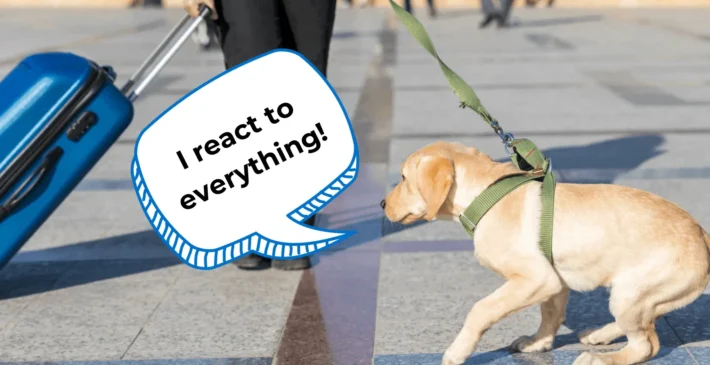
Reactive dogs react more intensely than other dogs. In a reactive dog's mind, every trigger IS a big deal and requires an over-the-top response.
Dogs that are reactive to everything can be terrified of other dogs and people, dislike certain elements such as fire or water, be reactive to all kinds of sounds, or be resistant to new experiences.
But why are some dogs more reactive than others?
Intervention and training are necessary if your dog shows signs of reactivity because unresolved reactivity can turn into defensive aggression. Additionally, reactivity problems stop our dogs from experiencing the best things in life!
Sure, you can give anti-anxiety medications, but will that truly solve reactivity?
In this blog, I will talk about the root of extreme dog reactivity, the common triggers of reactive dogs, and what you can do to help.
Key Takeaways
- Reactive dogs show extreme reactions like non-stop barking, uncontrollable behavior, and restlessness. They may also display signs of stress like pulling on the leash, aggressive behavior, or heightened excitement.
- Reactivity in your dog's behavior can stem from genetics, negative experiences, lack of socialization, training, or perceived lack of leadership. Knowing these factors helps tailor strategies to manage reactivity effectively.
- Stay calm, identify triggers, lead confidently, take things slow, and seek professional help from a dog behavior professional if needed. These steps, along with positive reinforcement and patience, can help your dog overcome reactivity and build confidence.
Table of Contents
What is a Reactive Dog: Reactive Dog Meaning
When dog owners come to me for their puppies' and adult dogs' reactive behaviors, they come with this question: “Is my dog showing normal behavior, or are they reactive?”
Dogs that display reactive behavior can show:
- An over-the-top reaction to stimuli.
- An extreme response to a trigger.
- Out of the normal reaction to what other dogs naturally ignore.
Your puppy or adult dog may have reactivity issues when they show an increased reaction involving non-stop barking, hyperactivity, and uncontrollable excitement.
(I talk more about dog reactivity issues in the video below.)
Here's a quick example.
Let's say your dog loves playing in a dog park. An average dog will still show excitement, but its reaction will be manageable.
It's a different story with reactive dogs. Any perceived threat or reactivity trigger causes havoc that you won't be able to control!
For reactive dogs that love the water), seeing a stream, beach, or river can cause a reaction that makes them uncontrollable and unable to pick up your instructions.
It's like they enter into a trance, which makes them hard to control!
Telltale Signs of Dog Reactivity
“Please teach me how to stop my dog's reactivity, Doggy Dan.”
To all who came to me for this, I usually tell them to always know the signs.
Sign #1: Extreme Reactions to Triggers
Dogs are not void of reactions; they flow with emotions like us.
But dogs with reactivity problems are different. There's one word to describe how they react to triggers: extreme. A dog notices their trigger fast, and they resort to a reactive way to drive the threat away.
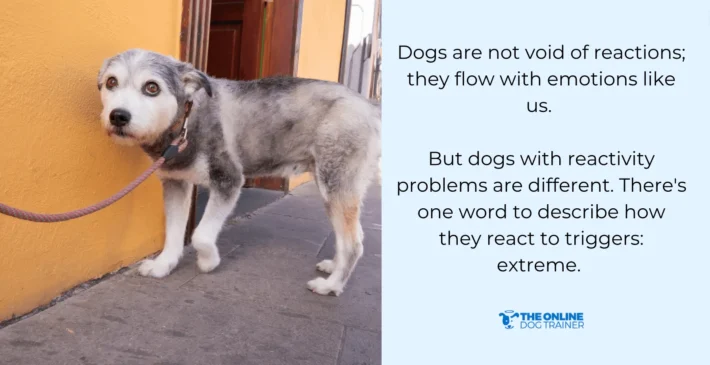
While other dogs will bark a little and then ignore, reactive dogs will bark non-stop.
While some dogs show increased interest in something or someone, a reactive dog will showcase hyperactive excitement!
Sign #2: Uncontrollable Behavior
Another sign of reactivity in dogs is uncontrollable behavior. Whenever your dog's reactivity is triggered, they tend to become so entranced they become too hard to control.
You can tell a reactive dog what happens after they see or sense a trigger. If they refuse to listen to your commands, pull the leash non-stop even after you tell them to stop, or if they bark non-stop, no matter how much you comfort them, you have a reactive dog.
Sign #3: Restlessness
Is your dog restless once they see something that scares or excites them? Your dog can be dealing with reactivity issues.
Here's a classic example.
After seeing another dog at the other end of the park, your dog begins to exhibit restlessness. They pull the leash non-stop, nudge you to either go to or away from the other dog, and bark to either engage with the other dog or scare it away.
Your reactive dog will continue their antics even if the other dog isn't doing anything.
If your dog only reacts like that in the presence of another dog, it's safe to say dogs can trigger your pet's reactivity.
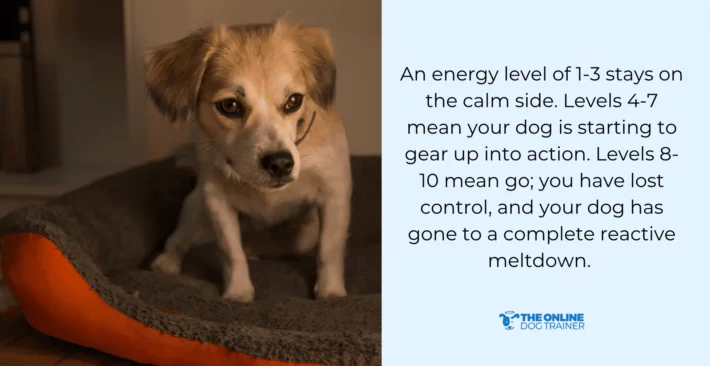
Sign #4: Increased Hyperactivity
If you want to check if your dog is reactive, I suggest observing your dog's energy levels.
An energy level of 1-3 stays on the calm side. Levels 4-7 mean your dog is starting to gear up into action. Levels 8-10 mean go; you have lost control, and your dog has gone to a complete reactive meltdown.
If your dog has the usual energy level of 1, a sudden change to level 9 or 10 can indicate that your dog is reactive.
Sign #5: Non-stop Barking
Reactive dogs often express their discomfort or agitation through incessant barking.
It's not just a casual bark or two; it's a relentless chorus of noise that seems impossible to quiet.
While a typical dog might bark briefly and then move on, a reactive dog will continue to bark, sometimes escalating in intensity, even when the trigger is no longer present.
This persistent vocalization indicates that your dog may be struggling with reactivity issues.
Sign #6: Leash Pulling
Leash pulling is typical in reactive dogs, especially when confronted with triggers.
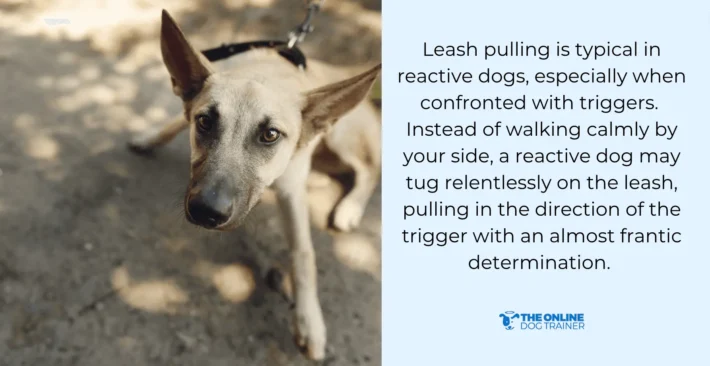
Instead of walking calmly by your side, a reactive dog may tug relentlessly on the leash, pulling in the direction of the trigger with an almost frantic determination.
No matter how much you try to redirect their attention or rein them in, they seem incapable of heeding your commands, their focus entirely consumed by whatever has triggered their reactive response… and the need to escape it.
Sign #7: Stressed Body Language
Dogs' body language is one of the most telling signs of reactivity. Reactive dogs often exhibit unmistakable signs of stress and tension when faced with triggers to their stress reactivity.
Watch for cues such as stiff posture, flattened ears, dilated pupils, panting, and furrowed brows. These subtle yet significant signals convey your dog's inner turmoil and discomfort, serving as a visual indicator of their reactive state.
Sign #8: Anxiety
Reactivity in dogs is frequently accompanied by underlying anxiety. Whether it's fear of the trigger itself or uncertainty about how to respond, reactive dogs often experience heightened levels of stress in triggering situations.
They can exhibit aggressive behavior and leash reactivity.
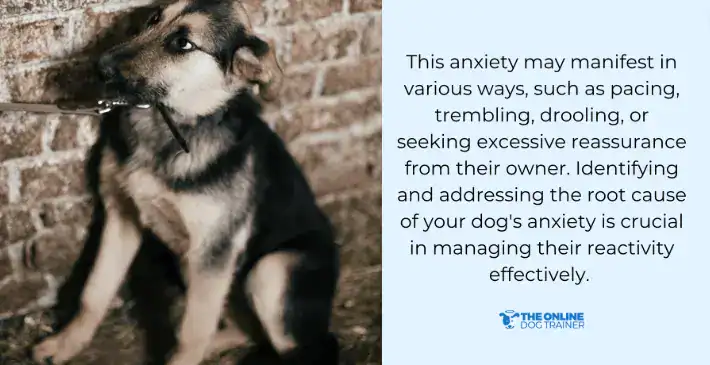
This anxiety may manifest in various ways, such as pacing, trembling, drooling, or seeking excessive reassurance from their owner. Identifying and addressing the root cause of your dog's anxiety is crucial in managing their reactivity effectively.
Sign #9: Increased Excitement
While reactivity is commonly associated with fear or aggression, some dogs may exhibit reactive behavior from excessive excitement.
These dogs become overstimulated by triggers, causing them to react impulsively and exuberantly. Their excitement can manifest in jumping, spinning, or frenetic behavior, making it challenging to redirect their focus or calm them down.
Recognizing this type of reactive response is essential for implementing appropriate training and management strategies.
Sign #10: Signs of Aggression
Aggression is the most concerning manifestation of reactivity in dogs.
When triggered, reactive dogs may display aggressive behaviors to cope with perceived threats or assert control over their environment.
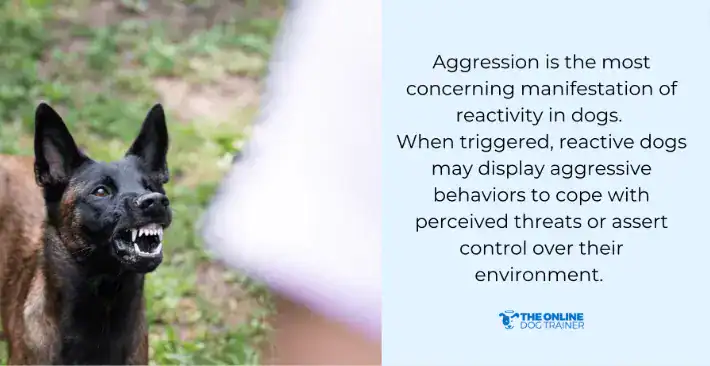
This aggression can take various forms, including growling, snarling, lunging, or biting.
It's crucial to address reactive aggression promptly and effectively through behavior modification techniques and, if necessary, professional intervention to ensure your dog's and others' safety.
Why Is My Dog Reactive to Everything: The Most Common Reasons Why Your Dog Is Reactive
Knowing what causes your dog's reactivity — especially if they're reactive to almost everything — can help you better understand how to help a reactive dog.
If you are wondering where your dog's reactivity stems from, here are some factors you can check.
Factor #1: Genetics
Not all dogs are created equal, especially if you're dealing with a dog genetically predisposed to be reactive.
Disclaimer: even if your dog's breed tends to be reactive, it doesn't mean it can never be trained or changed. Early training and intervention can turn reactivity around.
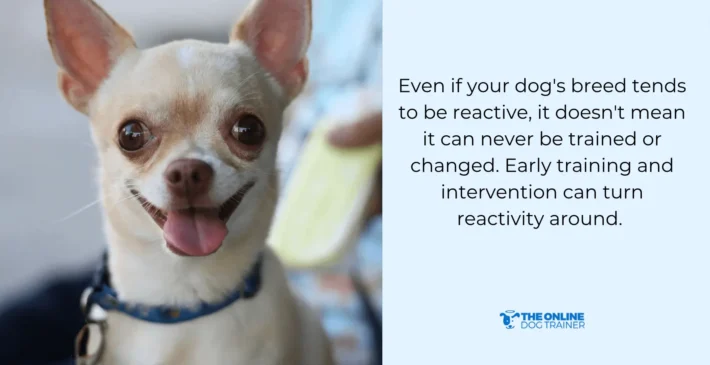
Some of the most common dog breeds known to be reactive include:
- Chihuahua
- Border Collie
- Belgian Malinois
- English Bulldog
- Australian Shepherd
- Boxer
- Cane Corso
- German Shepherd
The good news is that researchers have noted that only 60% of genetics influence a dog's reactive behaviors. With the proper training, you can help your dog overcome reactivity.
Factor #2: Negative Experiences, Traumatic Events, and Your Dog's Environment
Fear is a significant trigger for dog reactivity. When dogs are exposed to triggers bringing back negative experiences or memories, your dog can react in a harsh, defensive manner.
Take the time to check past events that could trigger an aggressive or fearful reaction.
Everyday experiences that trigger reactivity can include:
- Being abused by previous owners
- Exposure to violent dogs
- Deprivation and starvation
- Being in overwhelming environments and feeling anxious
Factor #3: Lack of Socialization
Does your dog react fiercely to seeing a person or another animal?
When a dog misses out on proper socialization, it's like they need to get the handbook for mingling with humans and other furry friends. Their aggression usually comes from feeling scared or anxious because they don't quite understand what's going on around them or how they're supposed to behave in social situations.
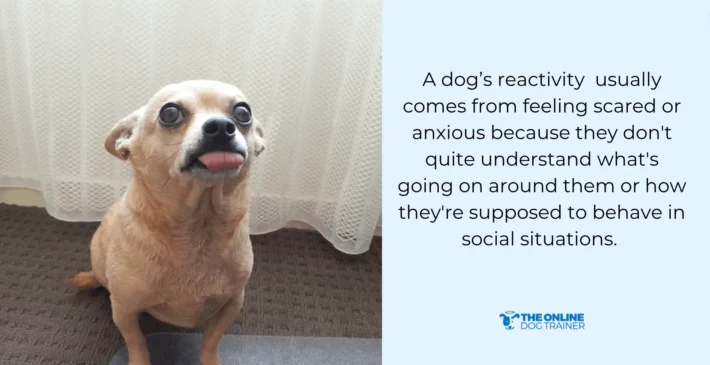
Your dog's tendency to lash out is like their built-in shield, gearing up to protect themselves in case the other dog gets feisty first. Plus, it helps them create some space, easing the tension stirred by the other dog barging in too close.
Factor #4: Lack of Training
Training is crucial for curbing reactive behavior and preventing it from spiraling out of control.
When dogs aren't trained, they remain cautious, always on edge around other dogs and their environment.
With guidance, they'll believe that reacting aggressively is their only defense mechanism, convinced that it keeps them safe.
But with proper intervention through training, you can steer your furry friend away from this harmful mindset. Training offers them a new perspective, teaching them that there are alternative ways to navigate social situations without resorting to extreme reactions.
It's like giving them a roadmap to understand better the world around them and how to interact with it positively, ultimately saving them from unnecessary stress and conflict.
Factor #5: You Have Not Established Leadership So Your Dog Thinks They're In Charge
My online dog training program, The Dog Calming Code™️, stands on this principle: a dog who thinks they're in charge is a dog that can't calm down.
Your dog has a number one priority: survival.
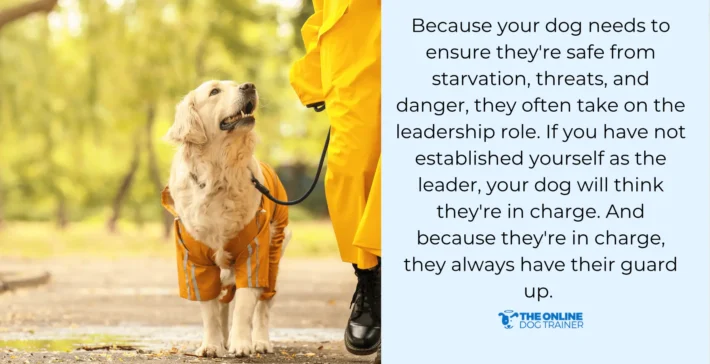
Because your dog needs to ensure they're safe from starvation, threats, and danger, they often take on the leadership role. If you have not established yourself as the leader, your dog will think they're in charge. And because they're in charge, they always have their guard up.
They're always anxious. They're always reactive.
Establishing leadership as a pack leader can help calm your reactive dog.
LEARN HOW TO CALM YOUR DOG FOR GOOD IN THIS FREE WEBINARPractical Strategies for Managing Reactivity: How Do You Help a Reactive Dog?
Tip #1: Keep Your Cool
To stop dog reactivity, start by keeping things chill.
When your dog's feeling reactive, staying calm yourself is super important. Dogs pick up on our vibes, so it adds to their tension if you're all stressed out. But remember, there's hope! Your dog's reactivity can be worked on.
Tip #2: Get to Know Their Triggers
Have you ever wondered what's bugging your pet? Are they new people, strange noises, or maybe other dogs? Figuring out what sets them off is vital in helping them out. Once you know their triggers, you can start finding ways to ease their worries. Avoid situations that may expose your dog to triggers.
Tip #3: Lead with Confidence
Being a leader in your dog's eyes isn't about being demanding or bossy; it's about being their guide and protector.
For your dog, everything is about survival; they have to know they can trust you BEFORE they will listen to you.
They'll feel safer and more secure when they see you as a calm, confident leader. So, take charge with kindness and understanding.
Tip #4: Take Things Slow
Slow and steady wins the race when it comes to helping a reactive dog. Pushing too hard too fast can freak them out even more. So, take baby steps and celebrate every little victory along the way.
Tip #5: Team Up with Other Dog Parents
If your pup gets anxious around other dogs, chatting with their owners can help. You can create a supportive environment where everyone's furry friend feels comfortable and respected.
Tip #6: Praise the Good, Redirect the Not-So-Good
Positive vibes all the way! When your dog behaves well, shower them with love and treats.
But if they slip up, gently redirect their attention and show them the right way to behave (this is where timeout comes in handy!). It's all about positive reinforcement and patience.
Tip #7: Offer a Helping Hand
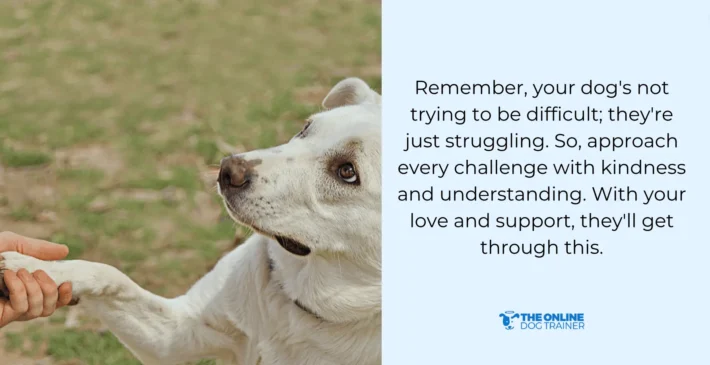
Remember, your dog's not trying to be difficult; they're just struggling. So, approach every challenge with kindness and understanding. With your love and support, they'll get through this.
Tip #8: Take a Deep Breath
Above all, be patient with yourself and your dog's reactive behavior. Progress might be slow, but every step forward counts. So, keep that chin up, stay patient, and trust that you're doing your best.
How to Build Confidence in Your Reactive Dog
Step #1: Familiarize with the Triggers
So, here's the thing: a dog's reactivity often stems from not knowing what's happening around them.
It's like when you're afraid of something you've never seen before. Reactivity can turn tiny stuff into big deals (ever seen a dog lose it over a squirrel?).
That's why showing your dog that whatever's setting them off isn't as scary as they think is crucial.
Step #2: Shower Them with Praise and Treats
Your dog's a quick learner. It's like hitting the jackpot for them when they connect their moments of bravery with your praises, cuddles, or even a tasty treat. They'll be lining up for more in no time!
Step #3: Make Good Stuff Happen Around Triggers
Help your dog see that triggers aren't all bad news.
Maybe it's playing their favorite game near something that usually spooks them or giving them a yummy treat when they handle a situation calmly.
They'll be less likely to get worked up when they start associating triggers with good times.
Step #4: Celebrate Progress, Big Time!
Positive reinforcement is so powerful when used correctly. Every little win is a cause for celebration! When your pup makes progress, whether it's a tiny step forward or a giant leap, let them know how awesome they are.
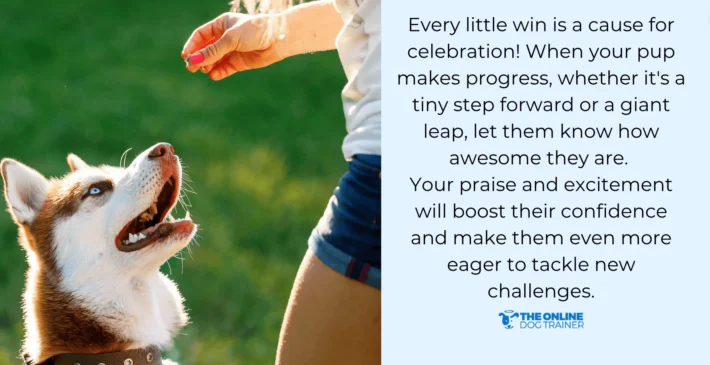
Your praise and excitement will boost their confidence and make them even more eager to tackle new challenges.
Step #5: Stay Steady
Keep on, and don't let frustration get the better of you. Your dog picks up on your vibes, so if you're all jittery, they might start doubting themselves, too. Stay cool, calm, and consistent, and you'll get together!
When to Ask for Professional Help
If you've done the necessary steps for reactive dog training, socializing, and exposing your dog, and they persist in their reactivity concerns, it's better to onboard an expert to help you.
Your dog may have deeper issues that an expert dog trainer or a professional dog behaviorist can help you with.
Here are some signs your dog needs professional intervention:
- No progress in reactivity
- Resistant to training
- Persistent reactivity despite several attempts for exposure
- New triggers pop out all the time
- Your dog is uncontrollable when reactivity kicks in
Solve Reactive Behavior in Dogs With The Dog Calming Code
Dealing with a dog reactive to everything can tug at your heartstrings and ramp up your stress levels! You might wonder, “Is there any hope for my super reactive pup?”
Well, believe it or not, there is hope. I know because I've witnessed countless success stories throughout my career, helping thousands of dogs like yours find their way to a calmer, happier state.
Understanding the inner workings of your dog's psychology is key. Once you grasp the inner workings behind their behavior and learn how to communicate with them effectively, you'll be amazed at how much they can dial down their anxiety and excitement.
This means they'll start looking to you for guidance rather than getting overwhelmed by every little thing.
I've poured all this knowledge into my online dog training program, The Dog Calming Code. Here, I delve deep into the Five Golden Rules of dog leadership, showing you how to empower your reactive dog to break free from their triggers. It's the crucial first step toward overcoming reactive behavior in dogs.

~Doggy Dan







2 Responses
I have been looking at a new lead for my dog
Can you recommend anything
Any standard lead will do. A front clip harness is very helpful though https://theonlinedogtrainer.com/harness-40-off/